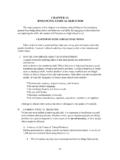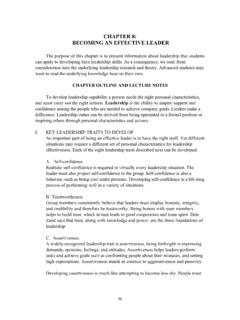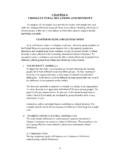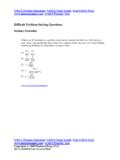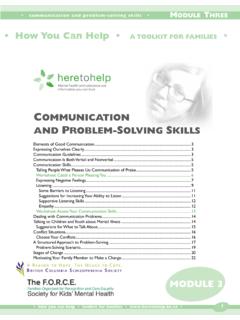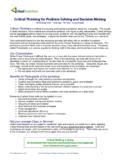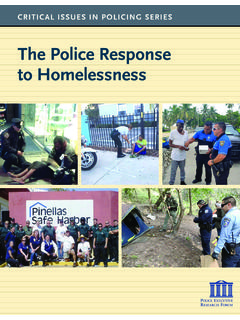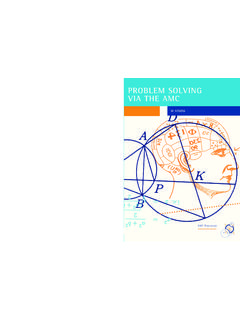Transcription of CHAPTER 5: GROUP PROBLEM SOLVING - …
1 CHAPTER 5: GROUP PROBLEM SOLVING . The purpose of this CHAPTER is to present practical information about GROUP PROBLEM SOLVING , thus enabling the reader to contribute more effectively to GROUP decision-making. CHAPTER OUTLINE AND LECTURE NOTES. Groups solve many key problems in organizations. Part of having high-level interpersonal skills is the ability to work closely with others in SOLVING problems and making decisions. I. RATIONAL VERSUS POLITICAL DECISION MAKING IN GROUPS. GROUP decision-making is the process of reaching a judgment based on feedback from more than on individual. Two different approaches to GROUP decision-making are the rational model and the political model. The rational decision-making model is the traditional, logical approach to decision making, based on the scientific method.
2 The search for optimum results is based on an economic view of decision-making people hope to maximize gain and minimize loss. Each alternative is evaluated in terms of how well it contributes to the goals involved in making the decision. The political decision-making model assumes that people bring preconceived notions and biases into the decision-making situation. Self-interest may block people from making the most rational choice. People who use the political model may operate on the basis of incomplete information. Sometimes it is difficult to determine if a decision maker is being rational or political, such as the example about the lack of a 13th floor in most hotels. II. GUIDELINES FOR USING GENERAL PROBLEM - SOLVING GROUPS. A. The GROUP PROBLEM - SOLVING Steps When team members get together to solve a PROBLEM , they typically hold a discussion rather than rely on a formal PROBLEM - SOLVING technique.
3 A more systematic approach would be to use the following steps: 1. Identify the PROBLEM . (What is the underlying PROBLEM ?). 2. Clarify the PROBLEM . ( GROUP members should see the PROBLEM in the same way.). 3. Analyze the cause. (The GROUP must understand the cause of the PROBLEM and 51. find ways to overcome the cause.). 4. Search for alternative solutions. (The alternative solutions chosen will depend on the analysis of the causes.). 5. Select alternatives. (Identify the criteria that solutions should meet, and then discuss the pros and cons of the proposed alternatives.). 6. Plan for implementation. (Decide what actions are necessary to carry out the chosen solution to the PROBLEM .). 7. Clarify the contract. (Restate agreements on what to do and deadlines for accomplishment.)
4 8. Develop an action plan. (Who does what and when to carry out the contract.). 9. Provide for evaluation and accountability. (After the plan is implemented, reconvene to discuss progress and hold people accountable for results that have not been achieved.). B. Managing Disagreement About GROUP Decision Making The idea is to manage disagreement so the decision-making process does not break down, and dissenters are not squelched. A study of 43 product development teams found that disagreement about major issues led to positive outcomes for team performance under two conditions: The dissenters have to feel they have the freedom to express doubt, and doubts were expressed collaboratively rather than contentiously. C. Inquiry versus Advocacy in GROUP Decision Making Inquiry involves looking for the best alternative.
5 Advocacy is fighting for one position. Decision makers who care more about the good of the firm are the most likely to engage inquiry. An inquiry-focused GROUP carefully considers a variety of alternatives and collaborates to discover the best solution. III. GUIDELINES FOR BRAINSTORMING. When the organization is seeking a large number of alternatives to the PROBLEM , brainstorming is often the technique of choice. Brainstorming is a GROUP PROBLEM - SOLVING technique that promotes creativity by encouraging idea generation through non-critical discussion. Brainstorming is used both as a method for finding alternatives to real-life problems and for creativity training. Eight rules for brainstorming are worth considering: 52. 1. GROUP size should be about five to seven people.
6 2. Everybody is given the chance to suggest alternative solutions. 3. No criticism is allowed. 4. Freewheeling is encouraged. 5. Quantity and variety are very important. 6. Combinations and improvements are encouraged. 7. Notes must be taken during the session by a person who serves as the recording secretary. 8. Invite outsiders to the brainstorming session. 9. Do not over-structure by following any of the ideas too rigidly. IV. GUIDELINES FOR ELECTRONIC BRAINSTORMING. Some of the problems inherent in conventional brainstorming have led to an electronic version. A. Limitations to Verbal Brainstorming Being aware of production-blocking mechanisms can help people improve their skill in brainstorming. Evaluation apprehension means that many people are unwilling to come forth with some of their ideas because they fear being critically evaluated.
7 Free-riding is just about the same behavior as social loafing. Free riders do not work as hard in a GROUP as they would if they worked alone. An inhibiting procedure in verbal brainstorming is that only one person can speak at a time. This limits the idea generation and production time available to GROUP members. B. The Electronic Brainstorming Procedure A recent development designed to overcome the PROBLEM of production blocking in brainstorming is electronic brainstorming. Using this method, GROUP members simultaneously enter their suggestions into a computer, and the ideas are distributed to the screens to other GROUP members. (Electronic brainstorming is really the same thing as brainstorming with e-mail.) GROUP members can build on each other's ideas and combine ideas.
8 During electronic brainstorming, individuals work in face-to-face groups, typically seated around a U-shaped table. Every time an individual enters an idea, a random set of the GROUP 's ideas is entered on the individual's monitor. Individuals can access the random set. An experiment with electronic brainstorming indicated that, with large groups, the method produces more useful ideas than with verbal (the usual type) of 53. brainstorming. Brainstorming via e-mail can increase both the quantity and quality of ideas. V. GUIDELINES FOR THE NOMINAL GROUP TECHNIQUE. A leader sometimes need to know what alternative solutions are available to a PROBLEM and how people would react to them. The nominal GROUP technique (NGT) has been developed to fit the situation. The NGT is a GROUP PROBLEM - SOLVING technique that calls people together in a structured meeting with limited interaction.
9 GROUP discussion, however, does take place at a later stage in the process. The nominal GROUP technique uses a six-step decision process. 1. Work team members are assembled to work on the PROBLEM . 2. The team leader presents a specific question. 3. Individual team members write down their ideas independently, without speaking to other members. 4. Each team member, in turn, presents one idea to the GROUP , but the GROUP does not discuss the ideas. 5. After each team member has presented his or her idea, the GROUP clarifies and evaluates the suggestions. 6. The meeting ends with a silent, independent rating of the alternatives on a 1-to-10 scale. Ratings are then pooled to select the best alternative. VI. USING STAND-UP MEETINGS TO FACILITATE PROBLEM SOLVING . PROBLEM SOLVING and decision making can sometimes be improved by conducting meetings while standing up instead of sitting down.
10 Some people are more alert when standing, and most people do not want to stand for too long so they reach a decision quickly. A study with the Lost on the Moon exercise suggested that people make decisions more quickly when standing up, without sacrificing decision quality. VII. USING E-MAIL TO FACILITATE GROUP DECISION MAKING. Appropriate use of e-mail and groupware can facilitate interaction among team members and GROUP decision making, while at the same time minimize the number of meetings. (Groupware is technology designed to facilitate the work of groups.). Such use of e-mail and groupware makes virtual teams possible. A. Using E-Mail to Facilitate Meetings By using e-mail, team members can feed important information to all other members of the team without the ritual of entering a meeting and passing around handouts.



